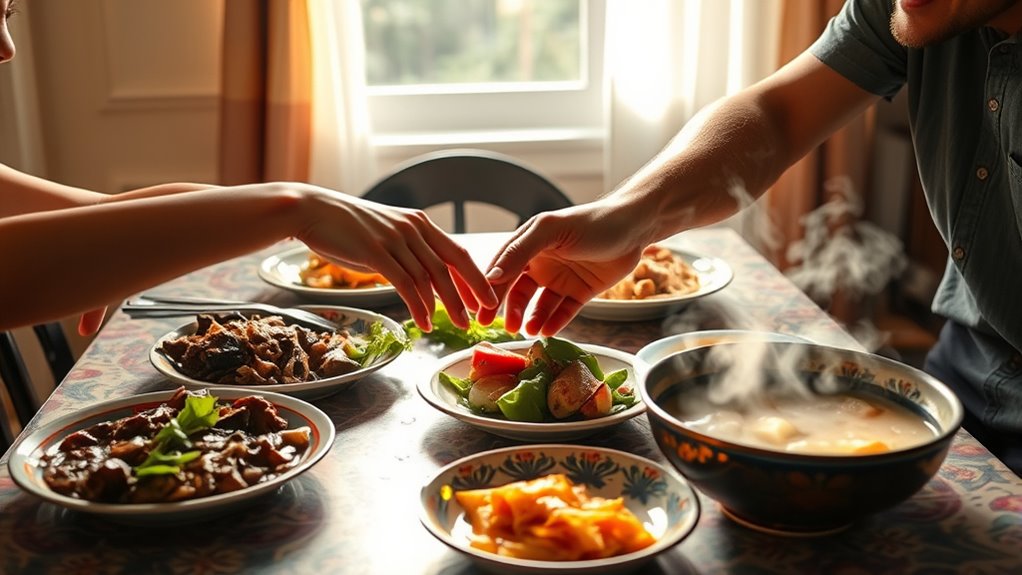Food plays an essential role in bonding with a Filipina. Shared meals reflect hospitality, love, and community, making them central to family gatherings. When you enjoy traditional dishes together, you’re connecting deeper and creating cherished memories. The *kamayan* style or family-style dining fosters conversation and unity, while every meal reflects cultural identity. Plus, cooking for her can express your care. The magic of Filipino cuisine goes beyond taste, revealing stories and traditions waiting to be uncovered.
Key Takeaways
- Sharing traditional Filipino meals fosters emotional connections and strengthens relationships, reflecting a shared cultural identity.
- Participating in *kamayan* dining encourages playful interaction and bonding over communal eating experiences.
- Dishes like adobo and lechon serve as conversation starters, linking family histories and values during gatherings.
- Food symbolizes hospitality, making guests feel welcomed and cherished, enhancing personal connections.
- Engaging in cooking together creates cherished memories, reinforcing emotional ties and a sense of belonging.
The Importance of Food in Filipino Culture
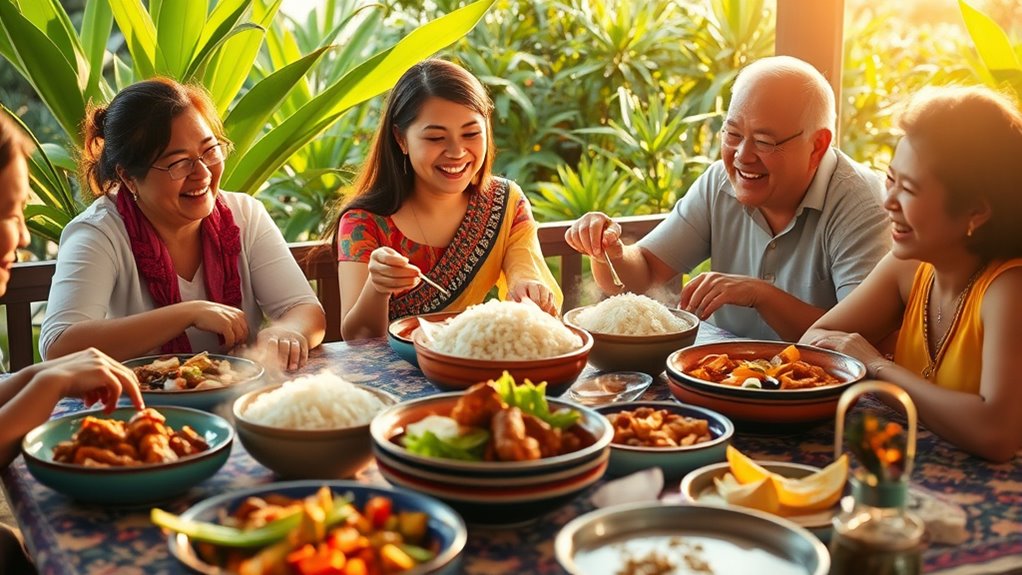
Food is more than just sustenance in Filipino culture; it’s an essential thread that weaves together hospitality, love, and community.
When you gather around the table, you’re not just sharing a meal; you’re embracing a rich tapestry of traditions and values. Each dish, whether it’s *sinigang* or grilled *inihaw*, reflects a blend of influences, showcasing the country’s history.
The act of eating together, especially using your hands in a *kamayan* style, emphasizes connection and unity. Meals are often served all at once, encouraging communal dining and conversation.
Through food, you express care and create lasting bonds, making every shared meal a celebration of cultural heritage and a demonstration of the warmth of Filipino hospitality.
Family Gatherings and Celebrations
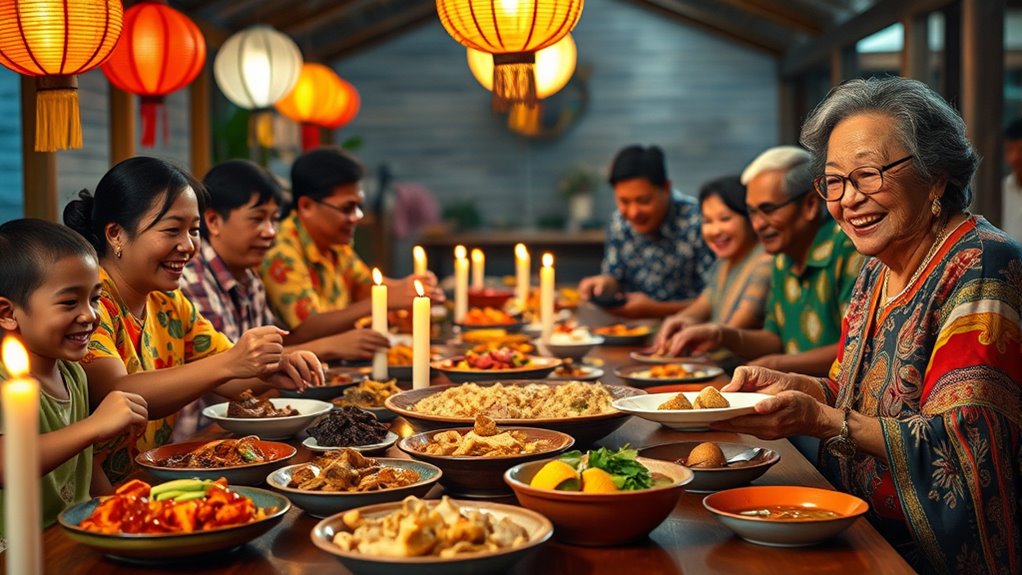
When you join a Filipino family gathering or celebration, you quickly realize that the experience revolves around shared meals, laughter, and connection.
Rice takes center stage, uniting everyone around a communal table. The *kamayan* tradition, where you eat with your hands, adds a fun twist, especially during festivals.
Rice unites everyone at the table, while the *kamayan* tradition brings playful joy to festive gatherings.
Dishes like adobo serve not just as meals, but as cherished links between generations, fostering closeness and cultural continuity.
Celebrations like birthdays and anniversaries are incomplete without a spread of food, showcasing the generosity and hospitality of Filipino culture.
It’s in these moments that food becomes more than sustenance; it embodies family unity, tradition, and identity, strengthening bonds that last a lifetime.
Hospitality and Sharing Meals
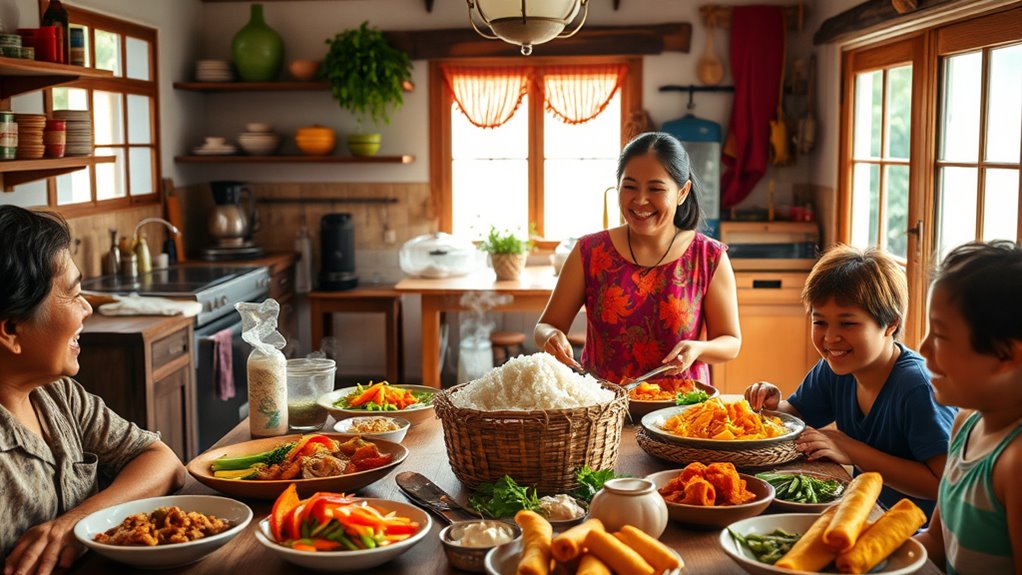
Filipino gatherings thrive on the warmth of hospitality, where sharing meals is a cornerstone of the experience. When you step into a home, you’ll likely hear inviting phrases like “Tuloy po kayo” and “Dito ka na muna,” immediately setting a welcoming tone.
Hosts go above and beyond, offering a variety of dishes such as adobo, sinigang, and kare-kare, ensuring there’s something for everyone. Even if you claim you’re not hungry, you’ll probably be encouraged to indulge.
This ritual of sharing meals fosters community bonding, creating a lively atmosphere filled with laughter and conversation. The aromas wafting from the kitchen signal a true Filipino welcome, where satisfying hunger and making guests feel cherished is a priority. Additionally, the act of sharing meals not only nourishes the body but also strengthens relationships, reflecting the deep cultural significance of food in Filipino society.
Emotional Connections Through Cuisine
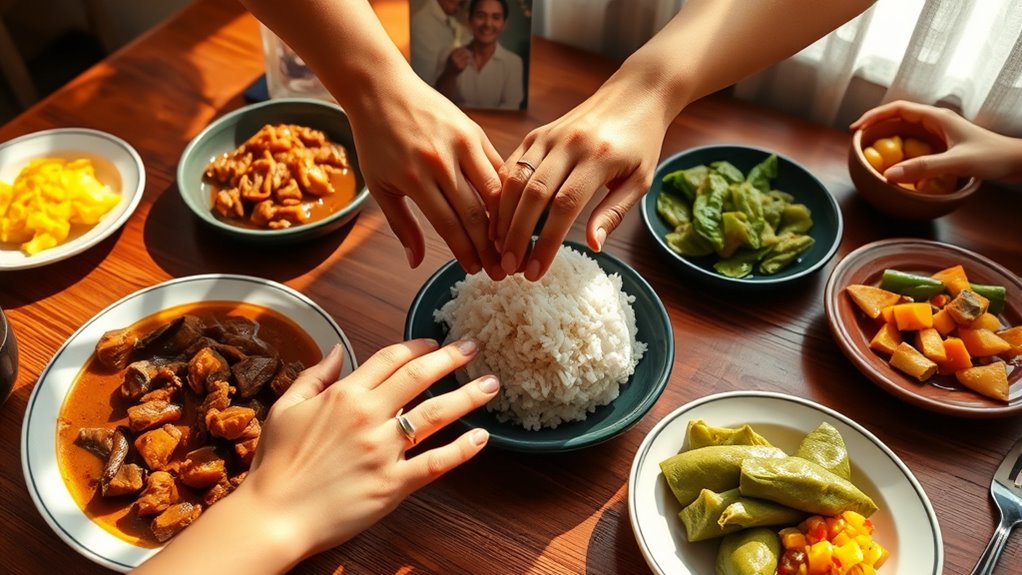
While sharing a meal, you might find yourself transported back to cherished memories, as the flavors and aromas evoke a sense of nostalgia. Food has a unique power to connect you emotionally, reminding you of home and childhood.
When you enjoy traditional cuisine, it reinforces your cultural identity, especially if you’re living away from your roots. Comfort foods bring security and warmth, enhancing feelings of belonging. Research shows that these meals foster social relationships, creating a community atmosphere. Moreover, engaging in regular exercise can complement these emotional connections by promoting overall health and well-being. Additionally, incorporating omega-3 fatty acids into your diet can further support cognitive function and enhance your shared dining experiences. Foods like baked kale can also provide essential nutrients, enriching your meals, and essential fatty acids are important for maintaining healthy hair and skin, which can enhance your dining experience.
Each shared dish strengthens bonds, as they symbolize love and care. By preparing and enjoying food together, you not only celebrate cultural traditions but also deepen your emotional connections, making the experience truly enriching. Incorporating elements like fermented vegetables can enhance the nutritional value of your meals, further promoting health and well-being in your shared dining experiences.
Traditional Dishes That Foster Bonding
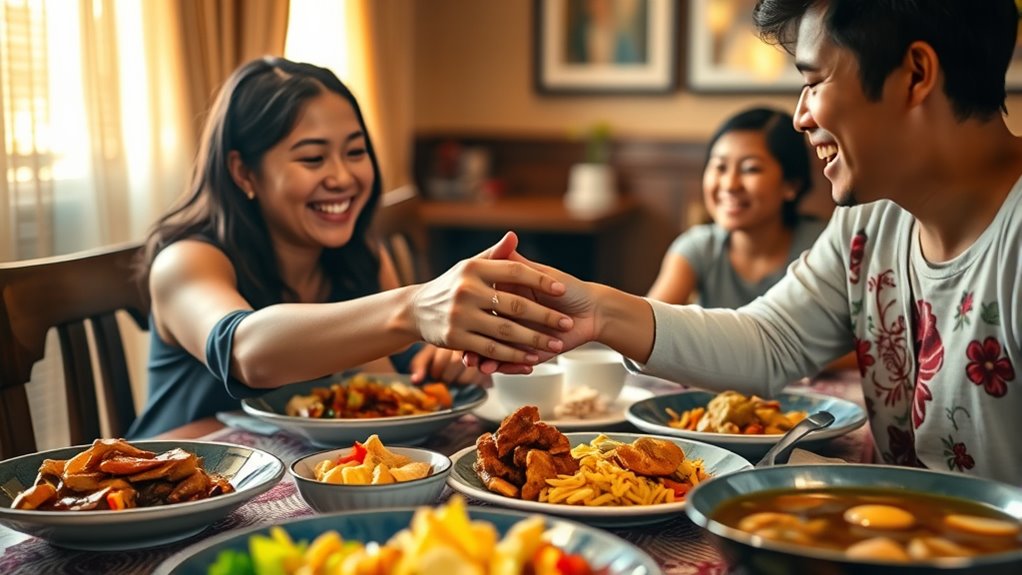
Sharing meals not only strengthens emotional ties but also highlights the rich tapestry of traditional dishes that bring people together.
In Filipino culture, family-style dining is common, fostering communal eating and conversation. Centerpieces like lechon at celebrations promote unity, while symbolic dishes such as lumpia shanghai and pancit celebrate longevity. Brazilian cuisine’s emphasis on communal eating mirrors this tradition, showcasing how food can connect people across cultures. In addition, shared culinary traditions often lead to the creation of new dishes that blend different cultural influences.
You’ll notice shared flavors, with everyone seasoning their meals to personal taste, enhancing the experience. Staples like adobo and sinigang provide comfort and familiarity, often enjoyed during family gatherings.
Even desserts, like bibingka and leche flan, symbolize community spirit. These traditional dishes aren’t just about nourishment; they reflect cultural values and create lasting memories, making every meal a bonding experience worth cherishing. Additionally, much like the Italian dish Cacciucco, which showcases a blend of flavors from the sea, Filipino cuisine also emphasizes the importance of diverse ingredients in creating a communal culinary experience.
The Role of Street Food in Socializing
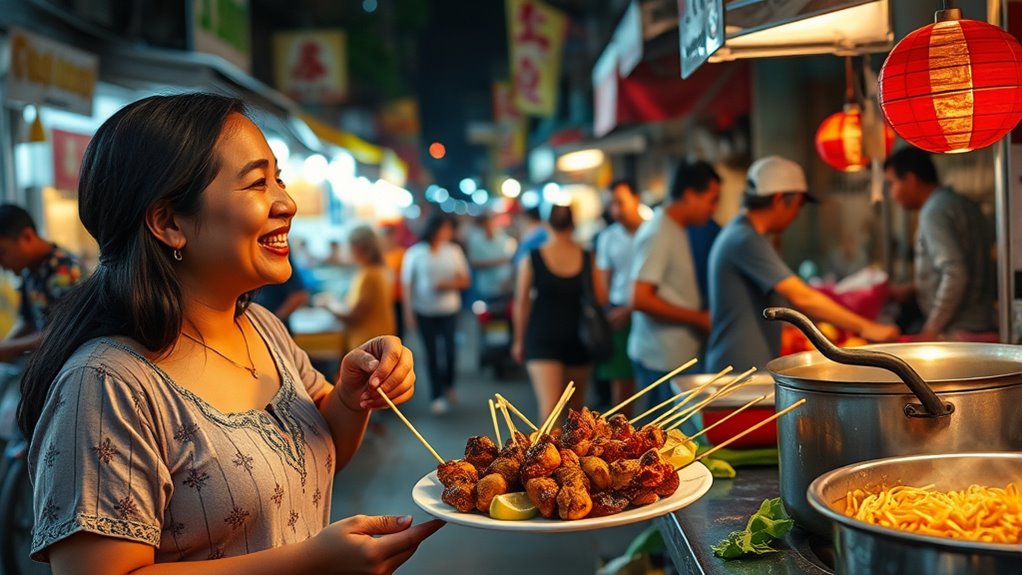
Street food plays an essential role in socializing, as it serves as a melting pot where people from all walks of life come together.
In the bustling streets of Manila, vendors offer a variety of delicious options that reflect the rich culinary diversity of the Philippines. You’ll find that street food fosters communal dining and sharing experiences, much like family gatherings.
These stalls, often located in high foot traffic areas, create informal gathering spots for spontaneous interactions among friends and strangers alike.
Street food stalls serve as vibrant meeting points, sparking spontaneous conversations among friends and strangers in the heart of the city.
Whether during daily routines or special celebrations, street food enhances social dynamics and builds community bonds. Its affordability guarantees that everyone can partake, making it a unifying element in Filipino culture.
Cooking as an Expression of Love

Cooking serves as a powerful expression of love, as it transforms simple ingredients into heartfelt creations that resonate with emotion.
In Filipino culture, preparing meals isn’t just about nourishment; it’s a tangible way to show care and create strong emotional bonds. When you invest time and effort into cooking, it highlights the value you place on those you’re serving. Gentle methods in cooking can foster a nurturing environment that enhances the emotional connection during meal preparation. Additionally, ensuring a comfortable cooking environment with proper ventilation can make the experience more enjoyable and supportive of well-being. This shared experience can also lead to unexplained phenomena that bring families closer together, creating lasting memories.
Whether it’s a family gathering or hosting friends, cooking reflects hospitality and respect, fostering community. Sharing recipes passed down through generations connects you to a legacy of love.
Each dish becomes a symbolic act, conveying affection when words fall short. Ultimately, cooking together strengthens ties, turning meals into cherished memories that nourish both body and soul. Additionally, incorporating regular physical activity while cooking can enhance the overall experience and promote well-being.
Food as a Means of Cultural Identity
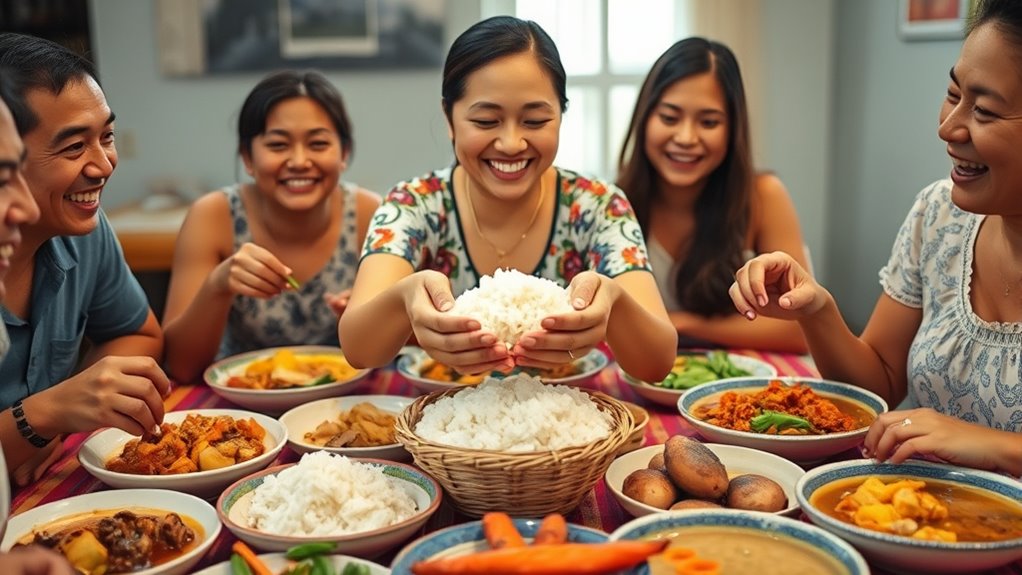
Food serves not only as a means of nourishment but also as a cornerstone of cultural identity in the Philippines. Each dish you encounter reflects the rich tapestry of Filipino values, emphasizing community and family bonds.
The diverse influences—from indigenous to Spanish—create a unique culinary landscape that showcases the country’s history. Regional specialties offer distinct flavors, enriching your understanding of local traditions.
Certain dishes hold symbolic meanings, tied to rituals and celebrations, reinforcing their cultural significance. As you savor traditional meals, you connect with memories and emotions that link you to the Filipino heritage.
Traditional dishes embody deep symbolism, linking us to cherished memories and the rich tapestry of Filipino heritage.
This culinary journey not only helps preserve cultural identity but also fosters a sense of belonging, whether at home or abroad. For instance, just as fried catfish serves as a communal dish in Southern gatherings, Filipino meals often bring families together to celebrate their heritage.
Culinary Traditions Passed Down Through Generations
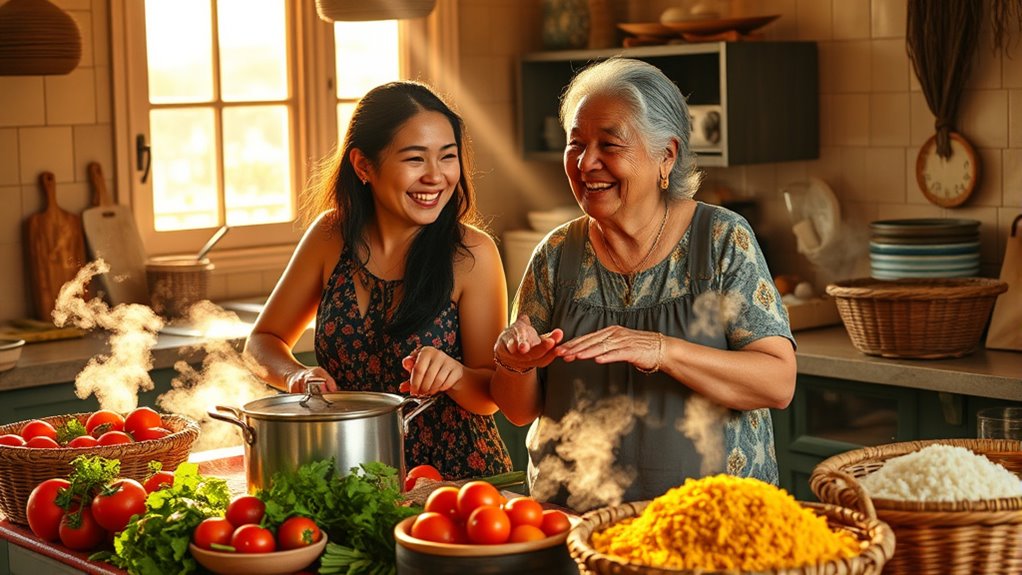
As you explore Filipino culinary traditions, you’ll discover that recipes are more than just instructions; they’re cherished family heirlooms passed down through generations.
These recipes often feature indigenous ingredients like root vegetables, tropical fruits, and fresh seafood, reflecting regional variations and cultural influences.
When you gather around the table for special occasions, you’re not just sharing a meal; you’re connecting with your family’s history and values.
Each dish, from “lak-dek” to caldereta, tells a story of your ancestors’ cooking methods and the love they poured into their meals. Additionally, similar to Filipino dishes, Idli Sambar showcases the importance of community bonding through shared meals in Indian culture.
Frequently Asked Questions
What Traditional Dishes Should I Learn to Impress a Filipina?
To impress a Filipina, you should learn to make some traditional dishes like Adobo, a savory stew that’s a staple in Filipino homes, and Sinigang, a sour soup that’s both comforting and flavorful.
Try mastering Lumpia, the delicious spring rolls that are perfect for sharing.
Don’t forget to make Halo-Halo for dessert; its colorful mix of ingredients is sure to wow her.
These dishes will showcase your effort and appreciation for her culture!
How Can I Participate in a Kamayan Meal?
Imagine a vibrant tapestry woven from threads of laughter and shared stories.
To participate in a kamayan meal, start by familiarizing yourself with the etiquette of eating with your hands. Gather around the banana leaves with friends, selecting colorful dishes together.
Embrace the communal spirit by engaging in conversations and sharing experiences. As you savor each bite, you’ll feel the warmth of connection, creating lasting memories that bind you to the moment.
What Are Common Filipino Food Etiquette Practices?
When dining in a Filipino setting, it’s important to respect common etiquette practices.
Always use your right hand when eating, especially in kamayan style, and avoid using your left. You should let elders serve first, showing respect for their wisdom.
Make sure everyone has enough food before you take seconds, as this illustrates courtesy.
Finally, if you need to use a toothpick, do it discreetly at the end of the meal.
Enjoy the experience!
How Does Food Influence Dating in Filipino Culture?
Food greatly influences dating in Filipino culture. When you share a meal, you’re not just enjoying flavors; you’re building connections.
Traditional dishes like *lechon* and *kare-kare* often accompany special dates, symbolizing care and affection. The act of dining together fosters intimacy and allows for deeper conversations.
Plus, the variety of flavors reflects cultural richness, making meals memorable. Ultimately, sharing food becomes a meaningful way to express interest and commitment.
What Ingredients Are Essential in Filipino Home Cooking?
In Filipino home cooking, you’ll find essential ingredients that create rich flavors. Rice is a staple at every meal, while coconut products add depth.
Don’t forget to include fruits like mangoes and vegetables such as water spinach. You’ll often use garlic and onions to build a flavorful base, with tomatoes for acidity.
Soy sauce and vinegar are must-have condiments, enhancing dishes with their unique tastes. These ingredients make Filipino cuisine both comforting and vibrant.
Conclusion
In Filipino culture, food isn’t just sustenance; it’s the heart of connection. When you share a bowl of sinigang or enjoy street food like fish balls together, you’re not just eating—you’re building relationships. For instance, imagine attending a family gathering where everyone pitches in to prepare a feast. That collaborative effort fosters bonds and creates lasting memories. By embracing these culinary experiences, you deepen your connection with a Filipina and celebrate the rich tapestry of her culture.
